Clemenger Media Sales provides you with the best advertising sales, content marketing, niche media, media sponsorship news:-
Content marketing is key to seo; seo is key to being found. Google promotes those that are relevant and recent. So your must have relevant and recent news related to your target market.
Clemenger Media Sales wants to help you. CMS has dozens of media clients: B2B, B2C – what is your target market?
CMS can help you own your target market.
Hope you enjoy the following:-
SEO Content Strategy: How to Copy Our Recipe for Success
Nathan Ellering

SEO moves fast. It’s an ever-changing discipline where what worked six months ago, might be completely out of date. However, there are some fundamentals that stay more or less the same.
When CoSchedule was first getting started, we knew we needed to attract the right kinds of customers. In order to pull those customers in, we also knew we needed to capture valuable search traffic.
That led to a lot of research.
Here are some of the basic strategies and tactics that guided our success:
- Focus on publishing compelling, quality content that is uniquely different and more valuable than anything else out there. That usually means it’s long-form content.
- Use the keywords your audience is searching for. Search engines understand synonyms and similar terminology, so using related keywords in multiple pieces of content helps the bots know what topics your site covers. That said, focusing on keywords for each piece of content you publish still matters.
- Offsite references, reviews, and social links play a role in how your content performs on search engines. Inbound links to your site are still important, and so is a logical sitemap with internal linking among pages.
- Content freshness matters. Keeping your content up to date helps search engines understand that your site is accurate today.
This is the basic SEO content strategy that has helped CoSchedule succeed. But how can you apply it yourself? That’s what we’ll cover in this guide.
Download Your SEO Content Strategy Templates
From organizing keyword research, to planning each piece of content you’ll create, you’ll get everything you need to execute your strategy with this trio of templates:
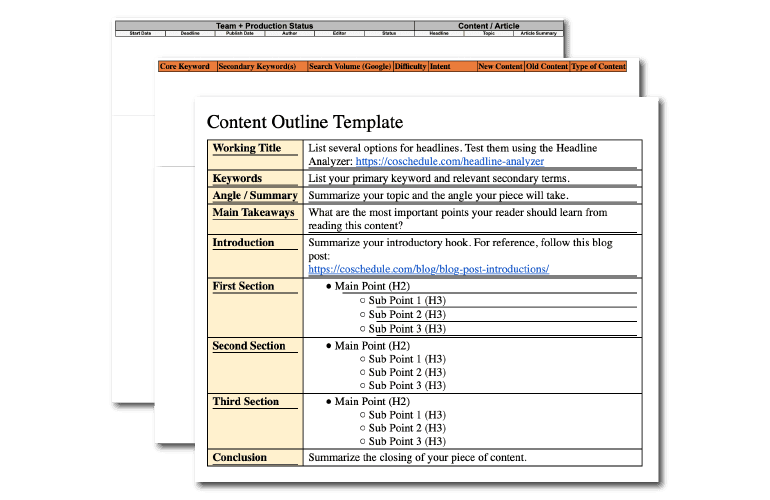
Get Your Content Strategy Templates
Plus, join our email list to stay up to date.
- Why SEO?
- Step 1: Locate Your Nearest Keywords
- Step 2: Learn Where You Stand
- Step 3: Incorporate Goal Keywords Into Your Editorial Calendar Process
- Step 4: Use Basic Keyword Identification For All Of Your Posts
- Step 5: Properly Optimize Your Content For Each Keyword
- Results From Our SEO Content Strategy (Or Simply, This Stuff Works)
- Create, Publish, And Share Your Optimized Content
- OK, Now Go Execute Your Plan
Why SEO?
You may be wondering why you still need to consider SEO in your writing with all of the changes that have been made by Google. The answer is relatively simple: For a long time, SEO was all about tricks and tactics. It was truly about optimization and opportunism, but not anymore. Now, SEO is about content. Lots of content.
In other words, SEO as we know it picked up camp and moved in with content marketing. We have a new roommate. Why not get to know it a little?
From what I can see, the opportunity for content marketers to use SEO-driven tactics is more applicable now than ever. We already have the content. What if we add a little science and tactic to our work–who knows where we might go in the future? We could even put ourselves on page one of search. Wouldn’t that be something?
How should the content marketer be approaching the search engines with our writing? This guide aims to answer these two questions. SEO may not be dead, but it has dramatically changed and that means there is a big opportunity for the content marketer who is paying attention.
Here’s a step-by-step guide to what you need to do to have a modern SEO-driven approach to content marketing.
Where It All Begins
When outlining an SEO strategy for content marketing, we take a slightly different approach than what we were used to. It is probably best to begin understanding how (and why) Google is rewarding longer-form content and other content that is visually focused. Google has started to see these elements as symbols of quality, and is doing a better job of connecting search users to quality content.
Again, that’s a good thing, but it doesn’t mean that some of the tried and true techniques of old SEO aren’t still viable. That’s where keywords come in.
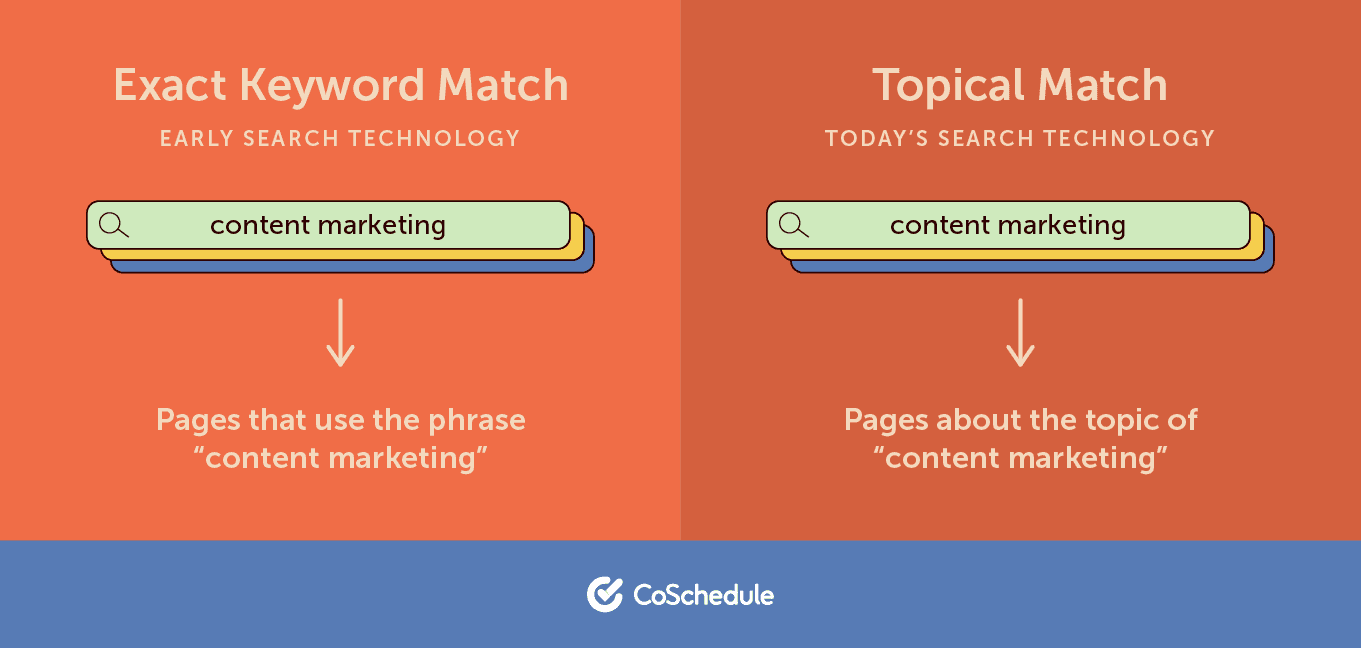
One of the most important aspects of search engine optimization has always been the keywords, those words that people use to find our content in search.
In the early days of SEO, the goal was to achieve exact keyword matching. This meant that the page we wanted people to find was perfectly tuned to show up in the search results when someone searched for that phrase. If you searched for “exact keyword match,” for example, you would find pages that used that phrase exactly as written. Not anymore. Now, you will find pages that discuss the general topic of exact keyword matching.
It may be subtle, but it is an important difference. Rand Fishkin of Sparktoro (formerly Moz) explains it well in his whiteboard Friday video.
All of that said, though, I still believe that most good SEO optimization still begins with the keyword. This hasn’t changed.
What’s changed is the framework we need to use for implementing those keywords into our writing. This is the method that I am going to break down for you in the guide. I am going to show you, step by step, how to use keywords to create an SEO driven approach to content marketing. Try not to think of it as SEO so much as smart content marketing.
Step 1: Locate Your Nearest Keywords
The first step is to find the keywords that matter most for you. There are several tools that will help you do this. The most notable is the Google Adwords Keyword Planner, a tool that is freely available with any Adwords account.
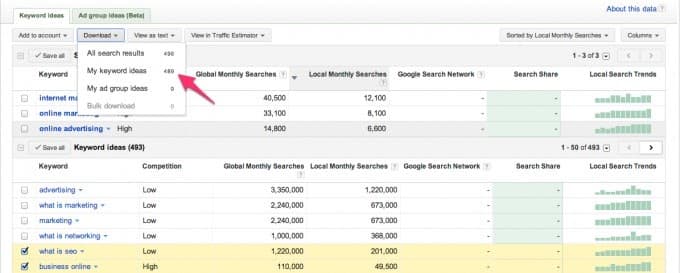
Should content marketers be using keywords in their writing process? Yes.
The concept here is very simple. Start by typing in one of the keywords that is most crucial to your business. Here at CoSchedule, for example, this would be something like ‘content marketing’ or ‘editorial calendars’. From there, Google will automatically provide you with a list of words related to your primary keyword that people all around the world are searching for.
As a content marketer, this is incredibly valuable! Not only do you get a host of keyword ideas, but you should also begin to understand your readers more than ever. This is what they are searching for. How cool is that?
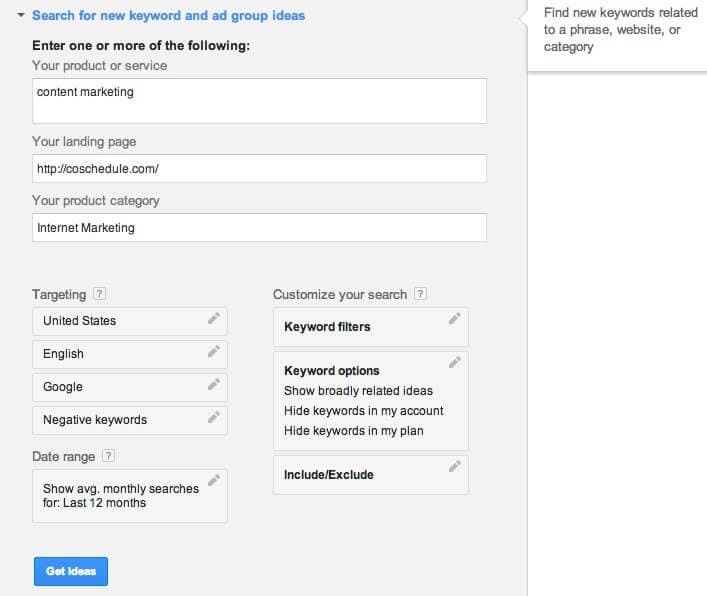
Keywords are located based on your website URL and product category. They are customized to you!
Once you have a list of results from Google, you can individually add keywords that stand out to you to your keyword plan.
Avoid getting overly aggressive, though. For example, in this screenshot I probably don’t need to add both “content marketing strategy” and “content marketing strategies.” They are a bit redundant, and not likely different enough for me to care about. Since “content marketing strategy” gets more attention, it would make sense to go with that.

Add important keywords and phrases to your keyword plan.
Your goal here is to create a list of 30-100 keywords that matter to your business, your audience, and to Google. You are doing research here, so the most important thing is that you learn what your audience wants, and what Google will reward.
Once you’ve created a good list, use the export option to download it as an Excel file, or whatever format you want to work with.
Key Point: Create a list of keywords that your blog should be targeting and keep it handy.
Step 2: Learn Where You Stand
The list of keywords you built using the keyword planner is your new content marketing checklist. These are the words that you want your site to “rank” well for on Google. I consider them a list of keyword goals to shoot for.
The next step is to load these goals into a tool that will help your track and monitor where your site ranks for each of these terms. For this, I like to use Ahrefs, but larger SEO tools like Moz are good options as well.
The purpose of Ahrefs is very simple. They aim to monitor daily changes to your search engine rankings and help improve where you show up in search engine listings. In other words, they will tell you where your site ranks on Google in respect to each keyword term that you add for your site.
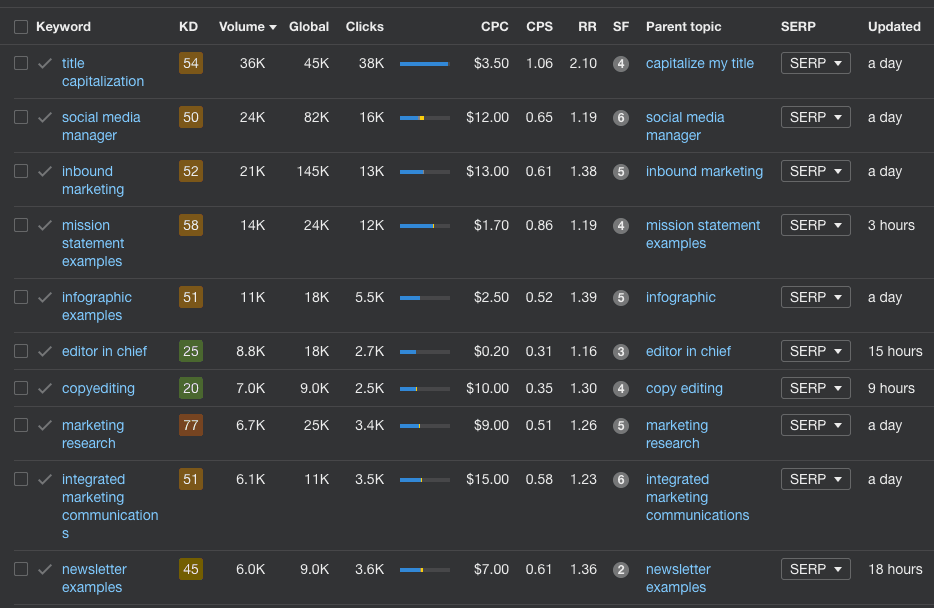
Ahrefs will tell you how your site ranks for each term. They will also monitor and report daily changes.
This is valuable information because it gives you a benchmark to work against. When you upload your initial list of terms, Ahrefs will give you an overall assessment of your site in comparison to your selected terms. Depending on how long you have been writing or working on SEO, your results may vary.
One of the hazards of a tool like Ahrefs is the frequency of information. On any given day you may log in to find that your rankings on several keywords have dropped for no particular reason.
This is a natural occurrence, and not something that you should worry about too deeply.
Ranking well on Google is an art, not a science. It is also a process, so don’t expect to land on top and stay there forever. 😉
Key Point: Use a tool like Ahrefs to monitor your keyword ranking and track your progress.
Step 3: Incorporate Goal Keywords Into Your Editorial Calendar Process
Once you have your marching orders (keyword goals), it is time to start incorporating them into your content marketing process.
At CoSchedule, our goal is to focus on one keyword phrase each week by adding a blog post with that keyword phrase to our editorial calendar. We don’t get overly scientific about it, we just plop it on there and leave things up to the designated writer to figure out.

Incorporate your keyword based posts into your editorial calendar.
Once the post is on the calendar, it will get written. If you aren’t managing an editorial calendar for your team, this is an excellent reason to do so, and one that we heartily recommend. When you pre-plan your content you can become much more purposeful and strategic with your goals.
Once you’ve worked through your keyword goals list the first time, be sure to refer back to Ahrefs regularly to help prioritize the keywords that you want (and need) to improve on.
Key Point: Add keyword goals to your editorial calendar each week to keep yourself accountable.
Step 4: Use Basic Keyword Identification For All Of Your Posts
It is worth mentioning at this point that you should never be writing a blog post where a specific keyword isn’t identified.
On our team, we try as often as possible to identify the keyword immediately when scheduling a post. Each time we create a post, we either identify the keyword in the headline itself, or note it in the comments field if we are choosing to write the headline later on.
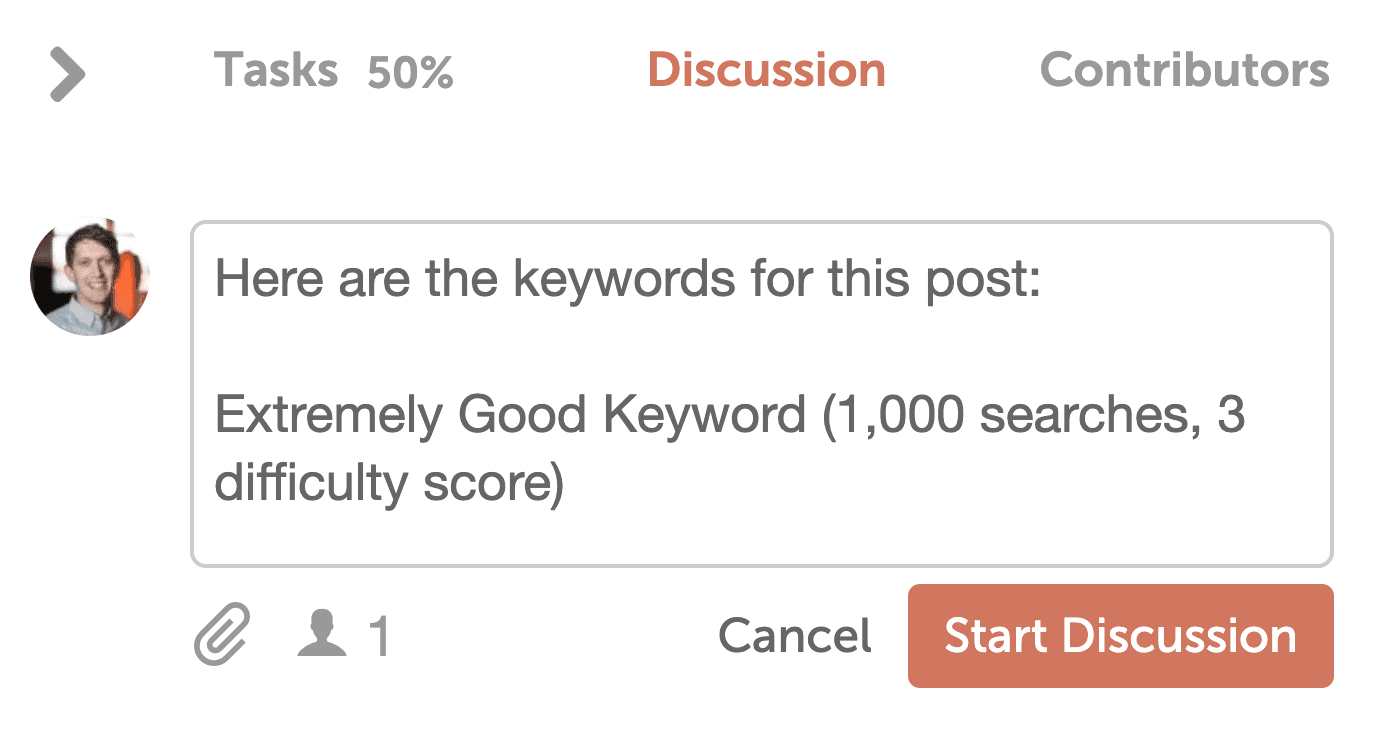
Identify SEO keywords before writing your content.
This is a good practice to get your team into, and will make a big impact on the quality of your posts. Not only will it add SEO value, but it will force your writing team to focus their writing on a well-selected and focused topic.
If you are having trouble identifying your keywords for one-off posts, there are two easy places you can go. First, you could always head back over to the Google Adwords Keyword Planning tool, but that might be overkill at this point. What I like to do is simply complete a basic Google search and take a look at the recommended search terms at the bottom of the page.
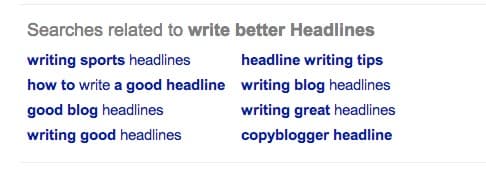
Related search terms on Google provide a wealth of keyword knowledge.
Key Point: Develop good habits, and declare a keyword for each post that you write.
Step 5: Properly Optimize Your Content For Each Keyword
Once you have a keyword selected for your post, you will need a few tools to ensure that your content stays on point. The two tools that we use here at CoSchedule are Ahrefs and WordPress SEO from Yoast. If you are on a budget the Yoast plugin is free, and will get you 90% of the way to where you need to go.
Both of these plugins work in a similar way. With each, you start by declaring the keyword phrase that you are using for the post. From there, the plugins will tell you how well you content ranks for those keywords. These plugins will evaluate your post based on several key factors:
Article Headline
It is considered best practice to include your exact keyword phrase in the headline of your post.
Page Title
The page title is the bit of text that will show up in your browser tab, or more importantly, at the top of your Google Search listing. You will definitely want to include your keyword in full here.

The Yoast snippet preview will give you a preview of your forth-coming search listing.
Page URL
Your keyword should be included in the slug of your URL. WordPress makes this easy to customize as long as you do it before the post is published.
Content
Yoast will want to see that the keyword is mentioned within the content of your post. With this, the more you have the better. If you can include the keywords in various sub-headlines you will even get bonus points.
Meta Description
The meta description is the short description of your post that will show up on Google. You will want to use your keyword phrase in this copy.
When writing your posts, you want to make sure they are as optimized as possible for the keywords that you are trying to reach. Yoast will give visual confirmation of your success.
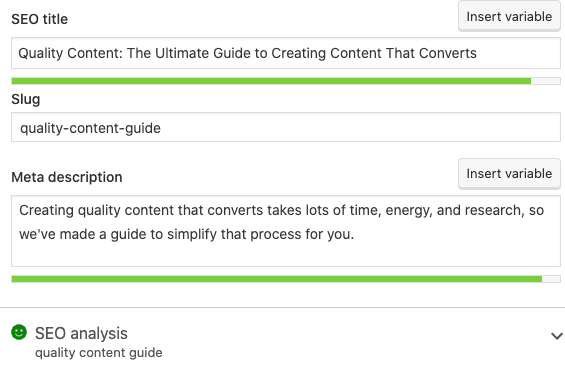
WordPress SEO plugin will visually show you how your articles rank SEO-wise.
At our office, we always shoot for green before we publish every post. Clicking through will provide additional information and suggestions.

Here’s a look at a Yoast page analysis. Lots of good tips here.
Topics vs. Strict Match
One thing that I want to point out is that you need to be careful about the difference between the strict matching of keywords and topic related search.
As Rand Fishkin pointed out the video posted above, Google cares more about how you cover the topic overall rather than the exact keyword itself. Yoast tends to lean too heavily on the strict match method, which is outdated by Google’s standards.
Results From Our SEO Content Strategy (Or Simply, This Stuff Works)
While there’s a lot to SEO, we primarily focus on applying keywords to compelling, quality content. There’s not much more to it than that.
And it’s working:
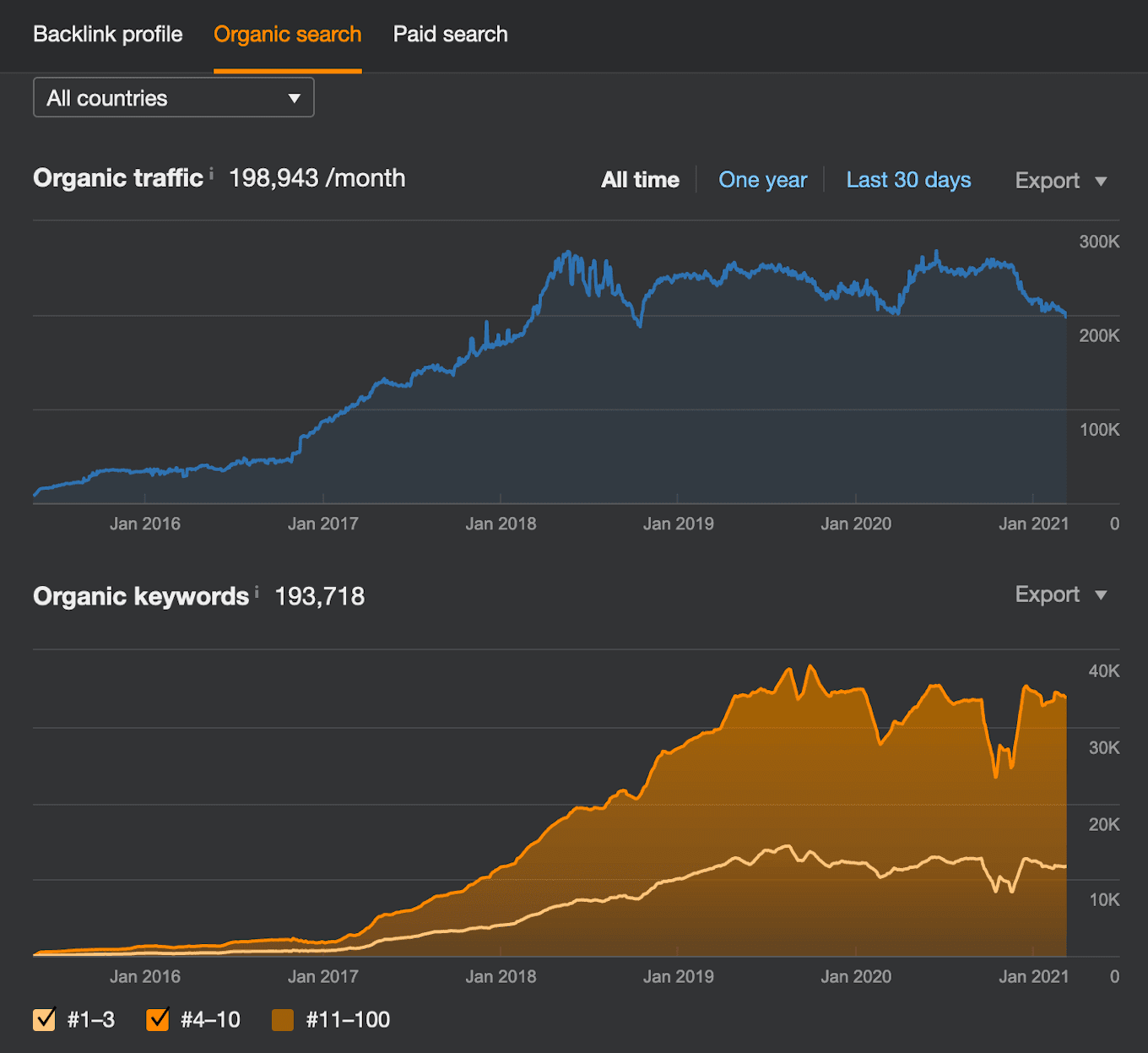
That’s our organic search growth from early 2016 through early 2021 according to Ahrefs. These numbers are not exact—they’re higher according to our Google Analytics and Google Search Console accounts—but what matters most is the trend line (which tracks roughly in line with what we see in other data sources).
Speaking of which, here is what we see in Google Search Console for the past 16 months (as of March 2021):
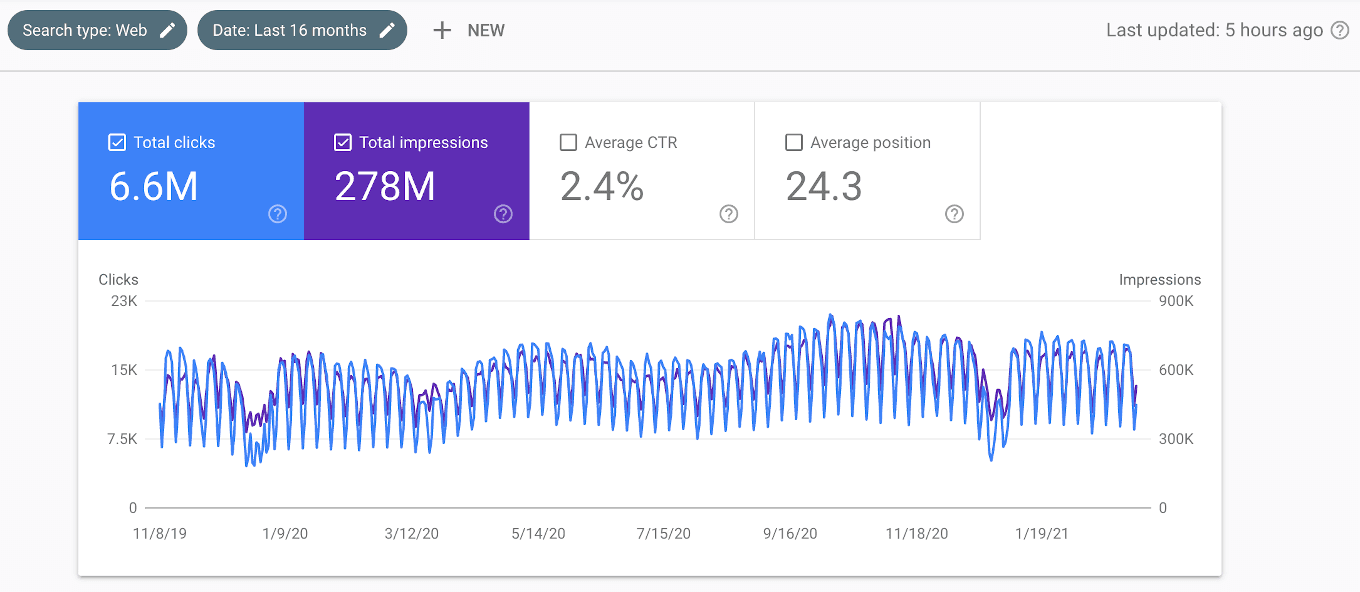
And here’s our 2020 organic search performance from Google Analytics (based on total unique website visitors):

Aside from some seasonal dips, it’s mostly trending in the right direction. There’s a levelling off in traffic after making major gains in 2017 and 2018, with newer content replacing traffic lost as older content decays (which could be rectified with a greater focus on refreshing older content), but overall, this performance has been steady.
And these results have helped us reach a larger audience, bringing in more than 800,000 email subscribers since 2014 and increasing our customer base.
SEO has been the most consistent tactic in our content strategy that contributed to these outcomes. We had a lot of growth with our marketing calendar itself that boosted these results beyond the SEO tactics you’re reading about now.
But it all adds up in the end.
Start With Your Goals
We have three core marketing goals at CoSchedule that all build upon one another. Focusing on SEO helps us meet all of those goals:
- Grow traffic: Enabling our audience to find CoSchedule through search engines, guest posts, and republished content helps us grow our traffic.
- Increase subscribers: The content we publish on our blog, for the niche keywords specifically, always contains free downloadable content in exchange for an email address. In that way, we optimize our content not only to be found, but to also convert readers into subscribers by providing valuable bonus content.
- Get more customers: The content we publish that targets the product keywords helps us turn readers into customers by showing the value CoSchedule provides as a marketing tool.
From the get-go, it just makes sense for us to prioritize SEO as a valuable component of our overall content strategy.
That said, certain keywords have more impact on those goals than others. For us, it makes sense to focus on both product and niche keywords. Here’s what to do:
- Prioritize each list of keywords according to importance for your business to help you reach your goals.
- Take a hard look at the average monthly searches, competition, and difficulty, and choose the ones that will be easiest for you to rank for now.
- Select the top 15 keywords from each list to have 30 total keywords to target in your first project.
Define Your Content Types
You could turn those keywords into a million different content formats, right? For each keyword, determine the best content type you’ll use to rank for that keyword.
At CoSchedule, we specifically think about the keywords first, then apply our knowledge of why our audience is searching for that term to the process. That helps us choose the right content type for each.
- Product: Think e-commerce pages, landing pages, and feature pages. These aren’t necessarily best for blog posts because folks searching for these terms are likely ready to buy. Use the best content types to help you sell your product or service.
- Niche: Think more traditional content marketing like blog posts, landing pages, templates, and tools.
Plan How You’ll Execute Your Project
Ask yourself, “Who’s doing what, and how will they do it?”
- Resources: Take people, tools, and budget into account: How you’ll actually create the content.
- Schedule: Plan to publish two pieces of content each week. That’ll help you knock out your first project in about two months while staggering the workload to not overwhelm your schedule.
- Tasks: Look at each piece of content you’ll create, and break it down into what needs to be done. It’s like a workflow. If you have team members, meet with them to understand where their skills will come in handy.
- Calendar: Plan your content on your marketing calendar, and add in the tasks for your workflow to nail every deadline.
Create, Publish, And Share Your Optimized Content
Google’s best results on SEO content strategy suggest tons of ways to optimize your content as you create and share it. Here are the main things we focused on to grow our #1–3 search results by 248%:
Focus on Compelling, Quality Content
Yeah, I know how many more times you can hear that before you go nuts. But it’s a lot easier said than done.
One of the top posts on this topic by Julia McCoy on Scoop.it suggests that brands like BMW, GE, and Red Bull are focusing on engagement tactics that are also helping people find their content.
And it’s no surprise that Neil Patel would say something similar with his take on interactive content reducing your bounce rate:
Engagement and interactive content go hand in hand, and we’ve known it for quite a while.
Interactive education was originally studied at home and schools even before the Internet was a thing.
Let me define interactive education: Interactive education is teaching that requires participation from students. Interactive content, as we’ll soon see, is the same thing—just swap out students for readers.
So while Neil is focusing on bounce rate, it isn’t that far of a leap to suggest that focusing on engagement as a tactic to reduce bounce rate keeps readers on your site longer, helping them understand your content is awesome and influencing them to share or convert.
The more awesome it is, the more times it’s shared. The more that happens, you’ll see more backlinks to your site. All of that is a good thing for SEO.
For CoSchedule, engaging content is actionable: Tips and advice to plan better, write better, share better—and all of that with free downloads to help you remember the tips you learn when you’re ready to implement the advice.
Write Long-Form Content
We started experimenting with long-form content in February 2014. In fact, Garrett did a whole little study with our data back then to share the results: 5 Things That Will Change Your Mind About Long Form Content Marketing.
It’s no guarantee that search engines will rank long-form content that’s about 2,000 words higher in their search engine results pages (SERPs) than a post that is around 500 words. But there is a lot to be said for the quality and depth of longer content that seems to complement the previous point on quality.
As Neil Patel puts it in another article on the KISSmetrics blog:
My number-crunching, data-loving self has come to the conclusion that search engines and people are really into long content. It converts better, shares better, looks better, and just is better.
But only to a point. I don’t want you to grovel in guilt or give up on blogging, just because you can’t write 2k-word articles. In an ideal world, we’d all be churning out 2k-word masterpieces. But in the real world, you don’t have to write 2,000-word articles.
That said, even when we recently published a blog post that reiterated that blog post length doesn’t matter, it is now just part of our content culture to provide long-form, detailed, and actionable content:

Jason’s on to us. We like long blog posts because they go way beyond scratching the surface to provide super actionable advice.
The results have been great for us, and we’re going to keep with it.
Build Internal Links
You never know which post will be the very first that someone sees on your blog. So we backlink to what we determine are the most important pages on our site from all of our new posts.
And you know what? Those pages that get linked to all the time are now some of our highest viewed and best converting on the entire CoSchedule website.
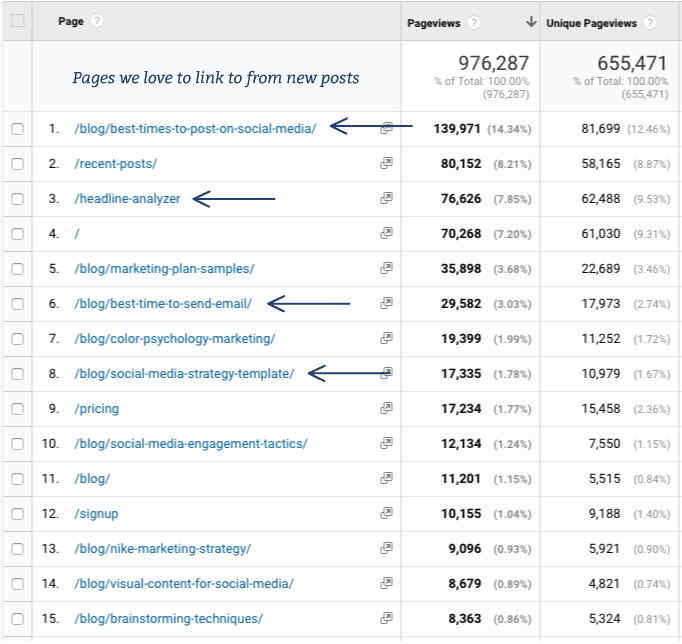
Internal linking is supposed to help search engines cruise around your site. We see this as an opportunity to focus on our audience, however, and direct them from new posts to some of the best content we’ve ever published.
Use the Keyword in Your Content
We keep this very simple:
- Page title
- Meta description
- URL
- Headline
- Image name and alt (mainly for organization)
- At least a few times in the body copy (including in subheadlines)
CMS, Clemenger Media Sales, Clemenger sales wants to help you understand how to maximise your advertising and marketing ROI.
The above article and following hyperlink are to help you with your media buying. CMS, Clemenger wants to help you with your advertising and marketing; your content marketing; your PR (we develop media partnerships / media sponsorships for you; so you can own your target market – more here:-
REST of the article = https://coschedule.com/blog/seo-content-strategy
